Thanks for your support! If you make a purchase using our links in this article, we may make a commission. And, as an Amazon Associate, I earn from qualifying purchases. See the full disclosure here.
One thing I consistently come across on RV forums is the concept of installing an RV doggie door. Mostly, it’s RV owners who want to know how to add a doggie door out of an entry door—not a task that anyone should take lightly. After all, an RV exterior is far different from a residential entry door.
It’s completely natural to have some reservations about cutting through fiberglass or aluminum siding (the two most common sidings on RV exteriors). Some RVs have an inner storm door or screen door, which may be (or may not be) a little more suitable for the task.
Some RV owners simply use their real utility door, which is typically used for storage but can be slightly modified for pet use. Of course, the problem with the utility door is that it’s may not big enough to accommodate larger dogs when the lower bunk is being used.
Can You Put a Dog Door in an RV?
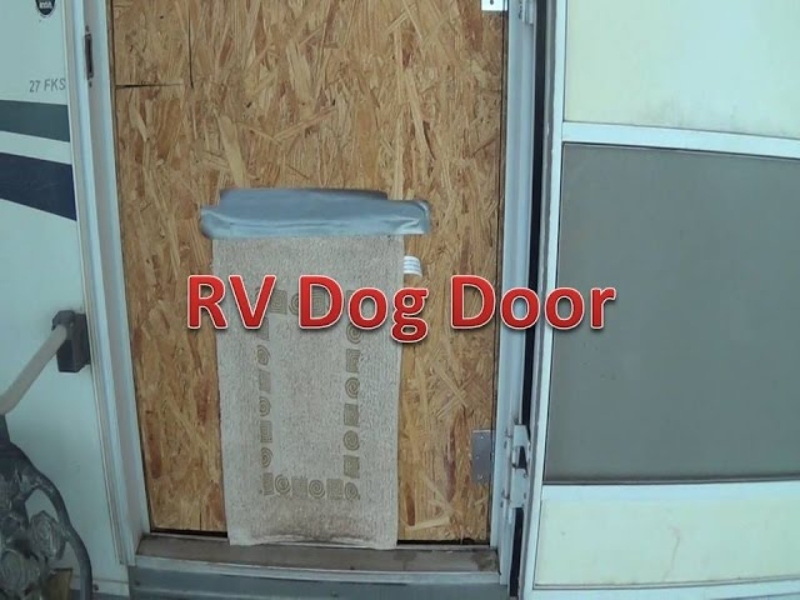
You can put a dog door in an RV, but it’s a more delicate job than installing a doggie door at your house. There are a few reasons for that. Here are some points to consider.
It’s not always the best idea to cut a hole in your door, depending on the size of your pet. With that being said, there needs to be a platform on the other side. Your four-legged friend is in for a not-so-fun surprise when he/she steps through the doggie door for the first time and finds nothing but air and a free fall to the first step.
There’s always the screen door option, assuming you have one and, assuming it’s rigid and sturdy enough to support a doggie door. So, while the answer is yes, there are some caveats that come with it (aren’t there always?).
Some experience in metalwork is always a plus but isn’t entirely necessary. Most doggie doors come with fairly specific instructions, along with a list of the tools you need to get the job done.
Is There an RV Door with a Dog Door?
You won’t find an RV door with a dog door installed on a travel trailer or motorhome. One of the most important reasons is that your pet could slip by you and run through the RV doggie door at the most inopportune time. The last thing anyone wants (especially campgrounds) is a loose pet running around off-leash.
Most states have leash laws, so it would be very uncommon to see an RV roll up in a campground and unleash their dog from the doggy door. At the same time, boondocking in a Walmart parking lot is not a good time to let the family dog come and go freely.
There are quick fencing options out there for you to take advantage of, such as the Airskirts Pet Patio, which is a rapid inflation solution for creating a quick, penned-in area for your doggie to go outside.
You might be surprised how little the RV manufacturers actually build their own doors. They typically outsource it to other manufacturers, such as Trimark Corp, Heritage Art LTD, All-Rite, Western Hardware Co., Diamond Roll-Up Door, Koshii Maxelum America Inc., and R&V Manufacturing.
In some cases, you can contact these manufacturers directly for custom door solutions. If you would prefer to install a compartment door as a dog door or an additional door for your dog to use.
Do RV Screen Doors with Doggie Doors Exist?
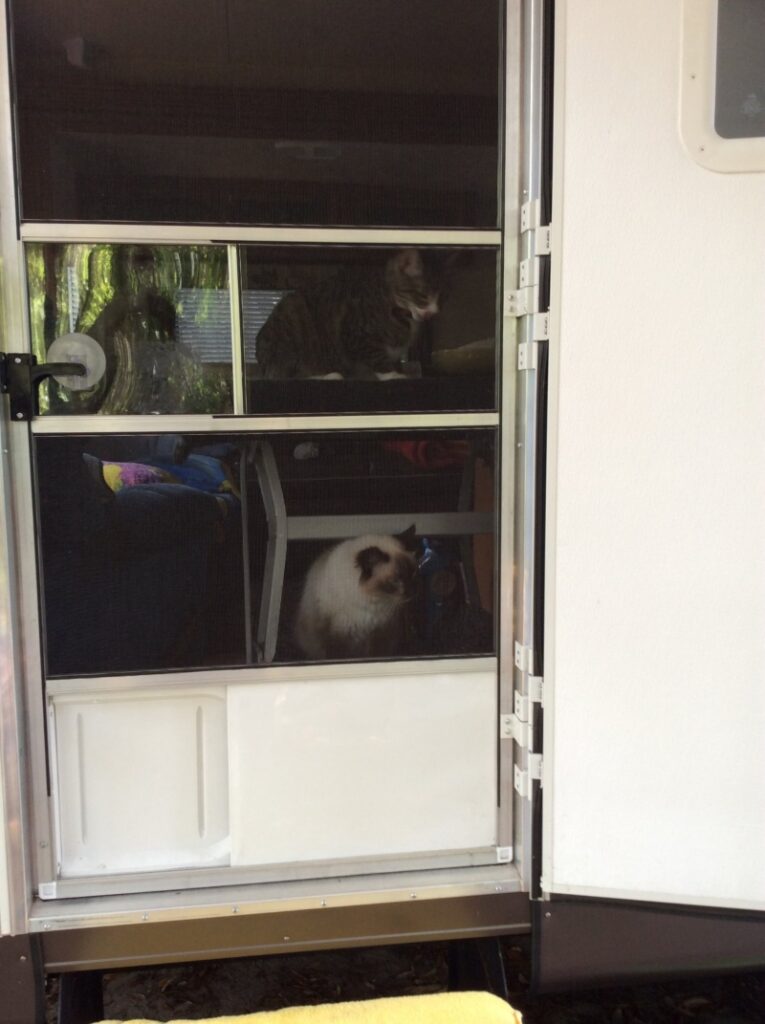
RV screen doors with doggie doors exist, but it’s often a third-market application. The way some screen doors are designed, it would be ludicrous to add a dog door to it (especially a large dog door) because you may end up compromising the door’s integrity.
It’s not just a matter of height and width either. Most doggie doors are simply too thick as well, especially when you’re hunting for larger doggie doors to accommodate a sizeable dog. Since screen doors are often very thin, a thicker doggie door simply won’t work.
How to Install a Doggie Door in Your RV
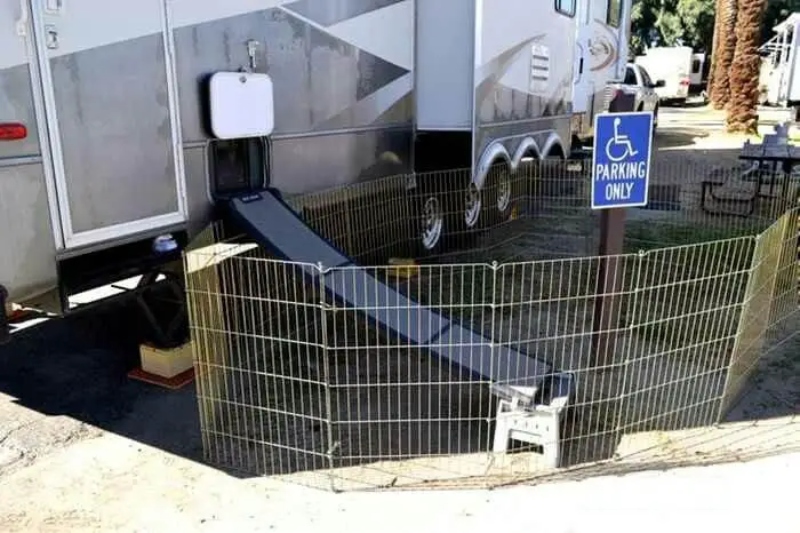
Now we arrive at the fun part. Just like you would a regular door, it’s a good idea to completely remove the RV door before you begin. It makes precision cuts much easier, and the best tools for this job demand a stable platform you can work over.
Of course, some choose to install their RV doggie doors in the wall next to the main door, which is fine too. Just keep in mind the structural integrity of the RV and the fact that you’ll have to work sideways against the wall. You’ll also have to install an outside step for easy access in and out.
1. Tools Needed
There’s a tool for every trade, as they say, and the tools for installing a doggie door are specific. You don’t want a circular saw, no matter how much you love the thing. Precision is the name of the game here, and a circular saw doesn’t cut evenly from top to bottom.
Whether you’re removing the door or installing an RV doggie door in the wall, the process is essentially the same, with the same tools involved. If you watch a lot of DIY projects for RVs on YouTube, you’ve probably noticed by now that most RVers go with the wall approach, rather than installing a doggie door in their RV doors.
- Measuring tape
- A square
- Jigsaw
- Construction Pencil
- Doggie door and associated hardware
- Screwdrivers (Phillips and/or flat)
- Dust mask
- Gloves
- Safety goggles
2. Measure and Mark Your Lines
This is the first thing you want to do. You don’t want to eyeball it, or you’ll inevitably end up with an RV doggie door that doesn’t fit or one that does and has gaps along the edges (or worse). A tape measure is great, but a square usually has measure lines on it as well. Measuring squares are much better for drawing your lines accurately.
Use a construction pencil so you can easily erase the lines later, in case any of them stick out.
3. Cut Out The Opening With A Jigsaw
A good jigsaw is worth its weight in gold. It will cut a straight line, even on the top and bottom of the cut. You can move as slow or fast as the blade allows. Most jigsaws also have a line guide in front of the blade so you can easily follow your marks as you cut.
Be sure to wear your safety goggles, dust mask, and gloves for this part. You don’t want to breathe this stuff in, and you certainly don’t want tiny slivers of RV door in your eyes. A good pair of gloves will help you maintain your grip on the jigsaw and slowly guide it through the cuts.
4. Install Your Doggie Door
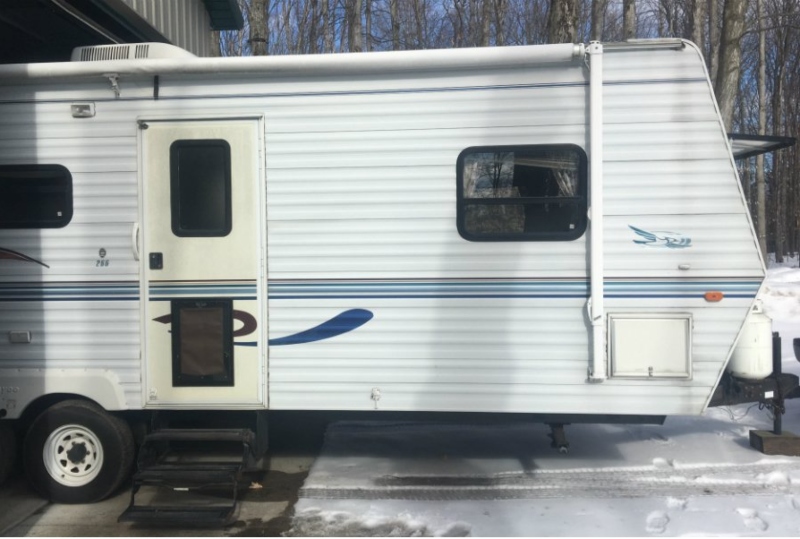
Once you’ve cut the gap, it’s just a matter of installing the RV doggie door. I would walk you through this one, but since every doggie door is a little different and comes with its own set of instructions, anything I tell you might be inaccurate.
Doggie doors usually come with all of the hardware you need to install them, just not the stuff you need to cut through the wall or door. You’ll have to take care of the latter on your own.
Is a Dog Door Worth it On Your RV?
Whether or not a dog door is worth it on your RV is up to you and mostly depends on your routine. There are some genuinely good reasons for having one. Most RV owners who have installed one certainly enjoy the convenience of it.
- It’s a good option for those late-night potty breaks
- Convenience throughout the day
- Freedom for your pet
- Easier to avoid accidents
It’s easy to forget about your pet if they’re out of sight, or out of mind. An RV doggie door allows them to come and go whether you forget they are outside or not. There’s no doubting its convenience factor, especially if you’re working on something and don’t want to be bothered to get up and down.
It’s also great at night, especially for older dogs or young puppies who don’t quite have the bladder control of a young, adult dog.
Why You Shouldn’t Get a Doggie Door on Your RV
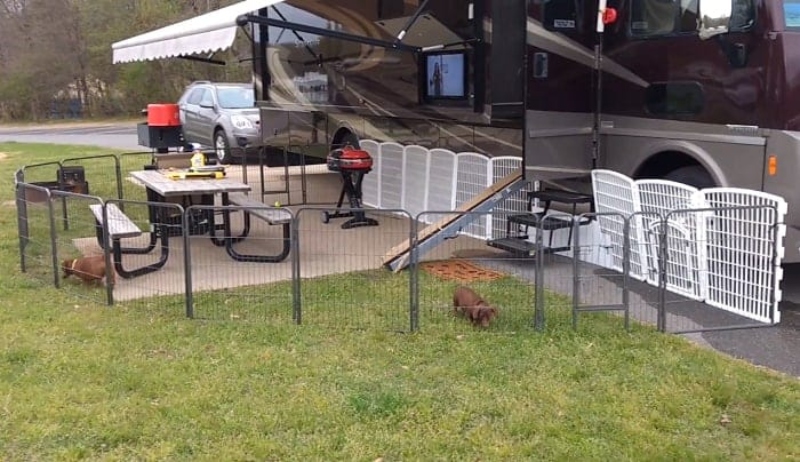
The most obvious reason you shouldn’t get an RV doggie door is the extra setup time. You’ll always have to set up fencing every time you set up your travel trailer or motorhome.
When pets are trained to use the RV’s doggie door to go outside on their own due to your limited camping situation, expect some type of behavior that says, “Mom, Dad, did you forget something?”
Even when you’re boondocking, you can’t just let your pet come and go, willy nilly, whenever he/she pleases. At least, you can’t let your pet out until you’ve scouted the area and know what’s outside. There are also a number of intangibles.
- The weather has to cooperate
- The Location has restrictions
- Most local municipalities have leash laws
- Predators
- The hosts won’t allow pet fencing
- There’s potential for theft since even a small door is a weakened barrier
You have to be a little more vigilant than you might think if you have a doggie door installed in your RV. Unless you prefer sticking to rural places, most local municipalities will have leash laws, regardless of your pet’s training level.
Campgrounds typically have leash rules as well. If you’re camping off the grid or way out in the boonies, potential predators become an issue. Most dogs are scavengers, rather than predators themselves and are no match for a mountain lion or an alligator.
Very few dog breeds can survive a bobcat or coyote attack. There have been many news stories of birds of prey that have flown off with toy or small-breed dogs. The point is, having a doggie door in an RV is not the same thing as having one in a house. Forethought and vigilance are required.
How Can I Protect My RV Screen Door from My Pets?
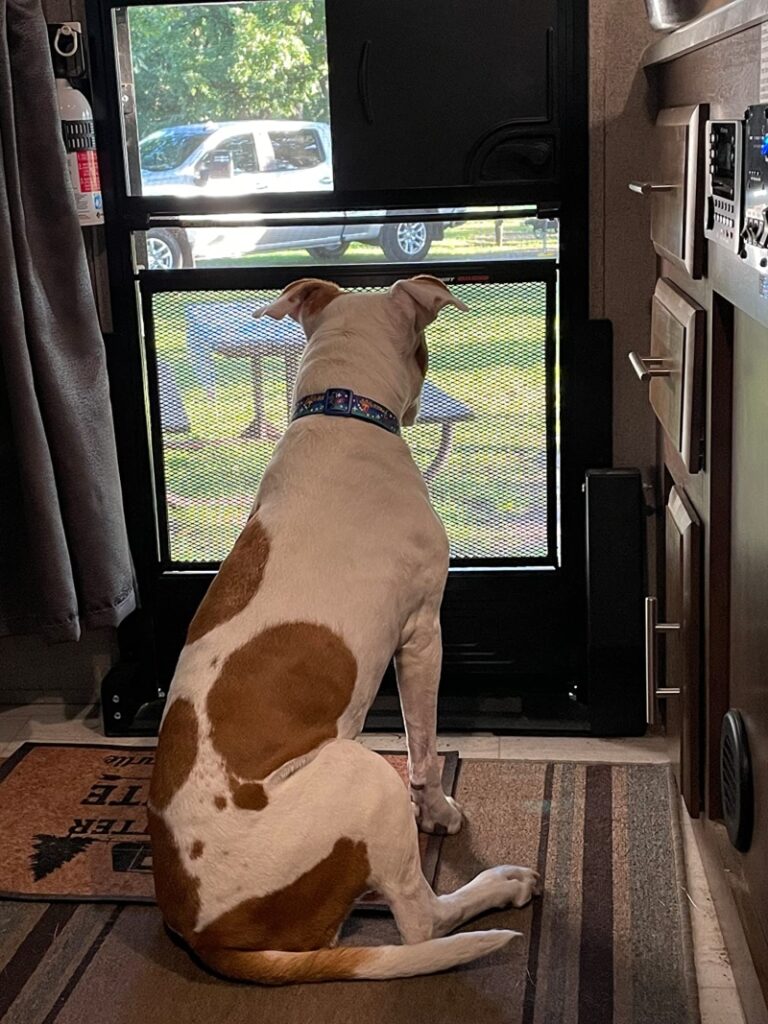
The best way to protect your screen door from your pets is to install a screen grille. Screen grilles are essentially the same thing as your screen, only hardened, with thicker materials in both the frame and the mesh.
Most dogs and cats will recognize some sort of funny barrier that stands between them and the outside world but they don’t realize they can’t scratch at it like they would a door when ready to go outside. Some standard screens won’t stand up to a single scratch from a dog or a cat without tearing.
There are plenty of grilles on the market, but if you’re looking for a known RV brand, Lippert should be one of the top brands on your list. Lippert is a company that made its name working in the RV industry for decades. Many parts in your RV are made by Lippert.
Their Screen Defender consists of a screen barrier made of thicker, powder-coated aluminum that installs in the same grooves your standard screen fits. They come in a variety of sizes, so be sure to measure your current screen before ordering a new one.
Can You Install A Cat Flap In an RV?
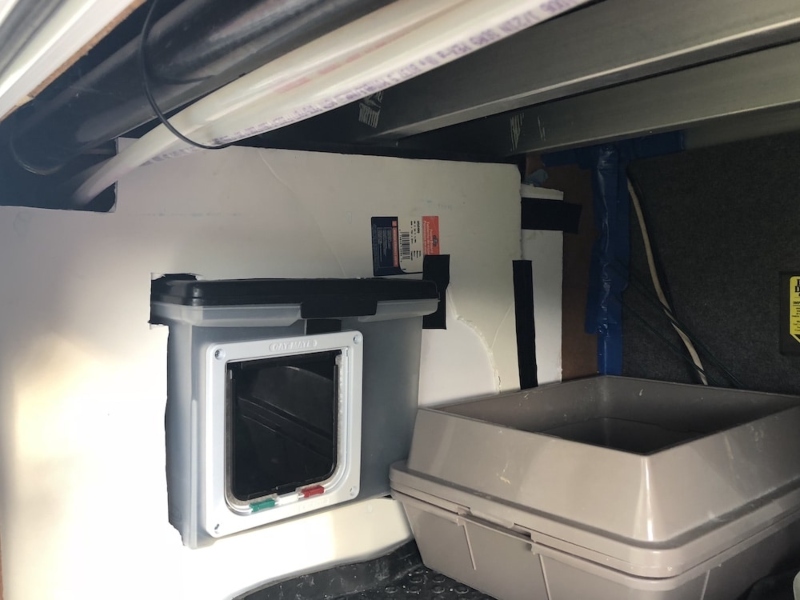
You can install a cat flap in an RV in a number of places, but the most popular spot is next to an exterior-access storage compartment. It’s not designed to let the cat go outside, just into the storage compartment, where its litter box is located.
There are a number of benefits to doing it this way. For one, it cuts down on the litter that inevitably gets tracked back out of the box and throughout the RV. For two, it really cuts down on that litter box smell that’s often so pervasive and thick.
It’s a very convenient setup. Though it cuts down on one of your storage compartments, it frees up some space within the RV as well. It doesn’t have to be a storage compartment, either.
You can use just about any empty space to install a cat flap. Some RVers install them next to old battery boxes, and others even create their own exterior cat slide-outs.
Final Thoughts on Doggie Doors for RVs
An RV doggie door isn’t too difficult of a project in theory or practice. The thing is, you have to have to consider the pros and cons. One of the big points is determining the best place to install the dog door. If you have a screen door, you can always reinforce it against potential damage as well.
As long as you have the right setup and follow the rules of the campgrounds or local municipalities you’re in, an RV doggie door is a fine feature to have. A cat flap is even better because it’s a great way to take advantage of existing storage space.
The good news is, whether you’re a cat or a dog lover, there are options out there if you want to install an RV doggie door. It only takes a minimal degree of carpentry skill or a hired professional. Once it’s in place, you’re all set to spend life on the road with your furry companions.
Related Reading:
1. How to Make Your RV Cat Friendly
2. 6 Best RVs for Traveling with Dogs
3. 10 Best RVs for Traveling to Dog Shows
4. DIY RV Cabinet Project to Memorialize a Pet
5. Tractor Supply Pet Wash: Wash Your Pet for $10
Thomas Godwin – Author and Part-Time RVer
Thomas Godwin is a full-time freelance writer with a BFA in Creative Writing, a U.S. Marine, and an avid outdoorsman.
Thomas’s love for RVing began at an early age spending time camping in the family vintage Airstream.
His background and education in writing, combined with his passion for the outdoors, can be seen in publications such as Camper Smarts and Vanlifers, as well as multiple animal and outdoor recreational publications.
When he’s not writing, he’s raising chickens and Appleyard ducks. Thomas also constructs teardrop campers (attempting to anyway) and kayaks the Blackwater River with his wife, two daughters, and his Dobermans.


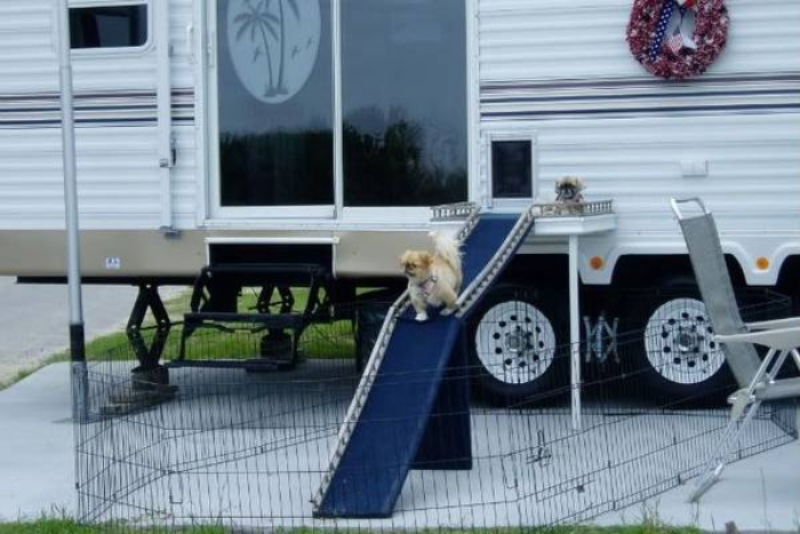
Thank you 4 ALL of this educational info!
U r Awwsum!